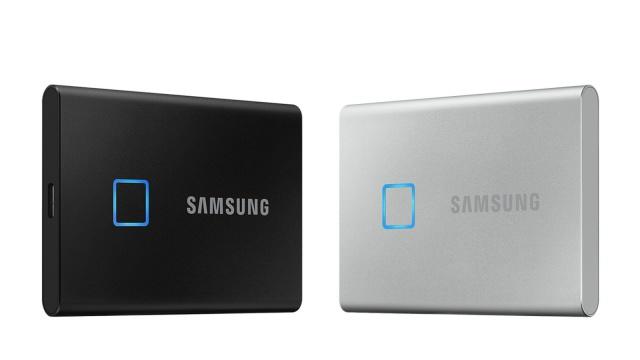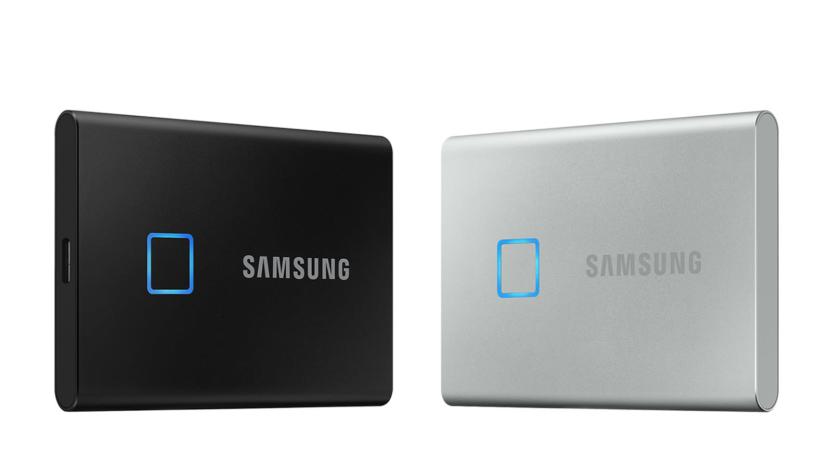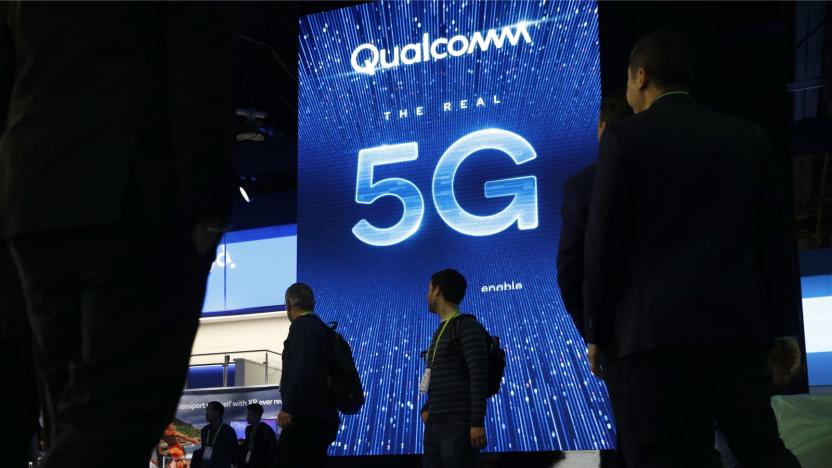fingerprint sensor
Latest

Samsung's fingerprint-secured T7 Touch SSD drops to $160 for 1TB
It's the lowest price we've seen to date for the external storage device.

Samsung’s T7 Touch SSD can be locked with a fingerprint
Security is especially important for portable SSDs, which might carry tons of sensitive information yet end up tossed in a bag. Samsung recognizes this. To make its latest portable SSD more secure, it has added a fingerprint sensor to the new T7 Touch, which was named a CES 2020 Innovation Awards honoree.

Qualcomm's latest Snapdragon chips include two with built-in 5G
Qualcomm just outlined the performance landscape for many of 2020's Android phones -- the company has introduced the Snapdragon 865, 765 and gaming-oriented 765G. They should improve performance in categories like AI and 8K video capture (Qualcomm won't share much more until December 4th), but this time around the highest-end chip isn't the star. The upper mid-range 765 series represents Qualcomm's first systems-on-a-chip with integrated 5G, saving them from using separate, power-hungry modems to take advantage of next-gen wireless. That could extend battery life, of course, but it should also make 5G handsets more affordable.

Windows 10 update pushes Microsoft closer to a password-free future
With its Windows 10 May 2019 update, Microsoft is getting one step closer to eliminating passwords. The company's Windows Hello has earned its FIDO2 certification -- an industry standard that deems Windows Hello a secure authenticator. Now, users running Windows 10 version 1903 will be able to login to devices, apps and online services using biometrics or PINs, rather than passwords.

The Nexus 6 nearly had a fingerprint sensor in its dimple
Motorola's Nexus 6 almost had a fingerprint sensor, but Apple spoiled the idea. In an interview with UK newspaper The Telegraph, former CEO Dennis Woodside (who now leads Dropbox) reveals that the handset's dimple was supposed to play home to a discreet recessed sensor, but its supplier couldn't meet its quality demands. "Apple bought the best supplier," Woodside explains, "so the second-best supplier was the only one available to everyone else in the industry and they weren't there yet." At least Moto didn't just, y'know, throw one in anyway.

Coming soon: laptops with fingerprint sensors built into the touchpad
At some point -- probably when the iPhone 5s came out -- fingerprint sensors became cool. Yes, they've been used on business laptops for years, but it's only recently that we've started to see them in stuff consumers would buy -- things like smartphones and tablets. Now, it seems, we're coming full circle. Synaptics, the leading maker of laptop trackpads, just announced something called the SecurePad, a touchpad with a fingerprint sensor built into the upper-left corner. Unlike existing fingerprint scanners for laptops, which require users to swipe their fingers over the sensor, this one uses capacitive touch, similar to the fingerprint modules used in devices like the iPad mini 3 and Galaxy S5. The result should hopefully be a more reliable experience than you would have gotten on older-gen laptops, but as we've seen with newer products, even touch-based fingerprint scanners can be a mixed bag.

New MasterCard combines a fingerprint sensor with NFC
For awhile now, there's been a number of companies trying to simplify payments for everyone. Google did so with Wallet and, most recently, Apple announced it would be doing something similar with the soon-to-be-launched Apple Pay, among others. Not surprisingly, MasterCard's, synonymous with paying for stuff, is working on a product of its own. In partnership with Zwipe, a company that focuses on biometric tech, MasterCard has built a charge plate with a built-in fingerprint sensor and NFC, albeit for trial purposes. The Zwipe MasterCard, as it is currently known, is said to be extremely secure -- all data is stored directly on the card, rather than an outside database, for example.

Oh look, another "easy" way to spoof Touch ID on the iPhone 5s
I'll be honest: I'm getting kind of tired of seeing words like "easy" and "simple" being used to describe the ridiculous how-to videos showing that it's possible to trick the Touch ID sensor on the iPhone 5s into believing you're someone you're not. The latest in what is sure to be a never-ending string of "me too!" hackers claiming they have figured out the best way to fool the iPhone is SRLabs, though I'm not seeing how this could possibly be categorized as "easy." Here's a list of the steps to pulling off this spoof (you can check out the process used by the Chaos Computer Club on our original article regarding the trick). First, snap a photo of a perfect print from the finger that will unlock the device. Without the victim knowing, of course. Use digital photo software to separate the print from the rest of the image and then "retouch as required." If your spouse or nosy friend has recently been taking Photoshop classes, this might be why. Print the image of the fingerprint on translucent plastic using black toner. Place the image of the print over a piece of photo-sensitive copper circuit board and then expose it to intense UV lighting. The folks from SRLabs used a face tanner for this. You have one or two of those laying around, right? Develop the circuit board in a bath of Sodium Carbonate Monohydrate or Potassium Carbonate. You know, just whichever one you have in the pantry. Etch the fingerprint into the copper by placing the copper board into an etching solution. Cover the print mold with graphite spray to help spoof the capacitive properties of a normal human finger. Cover the print in wood glue, let it dry, and then peel it from the mold. Oh, and the most important step of them all: Steal the phone from the victim, without them knowing it. If they find that their phone has been stolen, they can remotely wipe the device, which would mean you just did a lot of hard work for nothing. Then unlock the device. You only have a few attempts to do this correctly, because if you fail multiple times in a row the device will demand the numeric passcode and your plan is foiled. Easy! Right? RIGHT!? Seriously though, every time one of these groups comes forward with another slightly tweaked method for fooling Apple's top-of-the-line smartphone, I can't help but think how much easier it would be to just steal the phone in broad daylight and then torture the owner into unlock it themselves. If there's anything on your phone that would warrant someone to go through these insane steps to breach its security features, you should probably be using a 20-digit passcode and keep your phone within your grasp at all times. Touch ID isn't infallible, but it's better than a 4-digit passcode (which can be brute-forced in less than an hour or simply spied by someone peeking over your shoulder), and it's clearly better than no security at all, which is how many consumers use their phones every day.

Apple reveals Touch ID, a fingerprint sensor built into the iPhone 5s
In a move sure to delight security and privacy gurus, Apple revealed today at its iPhone event that the all-new iPhone 5s features a fingerprint sensor built into the home button. The technology is built into a ring around the home button that can scan sub-epidermal layers of your skin in order to identify you without the need to a passcode or other more archaic security measures. But beyond just allowing you to access your phone, Touch ID can be used to verify things like iTunes purchases without a password. Apple claims that the process of setting it up is super simple, and given the fact that it is a biometric sensor, it's certainly more secure than your mother's maiden name. To further please security advocates, Apple confirmed that the data is never stored on Apple's servers or backed up in the cloud -- it's all saved only to the device in your hand.

iOS 7 beta 4 hints at upcoming iPhone fingerprint sensor
Ever since Apple's purchase of biometric sensor company AuthenTec last year the rumor mill has been abuzz with predictions that a future iteration of the iPhone would employ built-in fingerprint authorization. Now, as 9to5Mac reports, Twitter user Hamza Sood has discovered a folder in the newly released iOS 7 beta 4 that references a biometric user interface, complete with descriptions of a setup process that includes images of a color-changing fingerprint and a person holding an iPhone with their thumb on the Home button. Earlier this month Apple was granted a patent for an in-display fingerprint sensor which would allow for biometric functionality while negating the need for a separate sensor panel. This new evidence certainly isn't a confirmation of such a feature being included in the next iPhone -- rumored to be called the iPhone 5S -- but it's definitely more validation than we normally see regarding rumors of this magnitude. [Image credit: Hamza Sood]

Apple files patent application for fingerprint sensor that can be transparent or opaque
While Apple has flirted with biometric-based patents before, we've yet to see them implemented in real-world technology. That hasn't stopped it from filing yet another one though, as the latest application reveals a fingerprint sensor apparently embedded into the iPhone itself. The patent describes a hardware "window" that can become selectively "transparent or opaque." When transparent, it would reveal a component comprised of an "image capture device, a strobe flash, a biometric sensor, a light sensor, a proximity sensor, or a solar panel, or a combination thereof" as a method of unlocking the phone. According to the filing, the biometric sensor in question might indeed be a fingerprint reader. The document goes on to describe an alternative method using face or eye recognition technology that can be used not just for security purposes, but for possible e-commerce solutions like completing an online transaction. Of course, take any of these patent applications with a generous pinch of salt -- we haven't seen an Apple stylus yet, for example -- but perhaps this is the reason Apple bought fingerprint sensor maker AuthenTec back in July.

Microsoft patent details pressure-sensitive Xbox controller for storing players' profiles
Biometrics and laptop security go together like business meetings and boardrooms, but this Microsoft patent hints that gaming could be the next frontier for fingerprint recognition. The claims for "personalization using a hand-pressure signature" detail a product that may look like your standard 360 controller, but it features sensors to detect a user's identity. It seems that, based on each gamer's unique hand pressure patterns, the controller can determine who is holding the device at any given moment and deliver personalized content based on that user's gaming profile. Whatever Microsoft's mystery controller may be, E3 is just a few weeks away, so perhaps we'll learn more then.

Apple patent filing details "touch and go" USB devices
digg_url = 'http://digg.com/apple/Apple_patent_filing_details_touch_and_go_USB_devices'; We already caught sight of a whole batch of Apple patent applications earlier this month, but it looks like the company still has a few more big ideas up its sleeve, which may or may not actually come to fruition. The most interesting of those is what's described as a "Portable Device Capable of Initiating Disengagement from Host System," or a "touch and go" system as AppleInsider calls it. That, as you may be able to discern, is essentially a touch sensor tied to a USB drive or other USB device, which would be able to sense when you touch it (or even when you're about to touch it, apparently), and then disconnect the device from the computer before you're able to cause any data corruption. Better still, the system could apparently also double as a fingerprint sensor in some implementations, and completely lock down the device if an unauthorized user grabs it.[Via AppleInsider]

Seiko Epson developing tiny fingerprint sensor
With all this paranoia surrounding identity theft, we've seen fingerprint sensors on everything from hard drives to door locks to laptops, but the common feature on all of those is the relative thickness of the device. By "relatively thick," we mean that these current tags would probably bulk up your wallet in a bad way should they ever be used to tag things like credit and debit cards. Seiko Epson is on top of it, however, and are developing a ridiculously thin (0.2mm) fingerprint sensor that will allow mobile devices to be easily secured by biometrics. Potential applications, aside from deterring thieves from swiping your self-authenticating credit card, are tagging cellphones, MP3 players, and essentially anything that can fit into your pocket. The sensor operates by reading the faint electric current that emanates from your fingertip and conveys your specific print pattern for verification -- if it detects somebody trying their best to mimic your phalanges, it deactivates the device, rendering it useless to the perpetrator. While there's a certain sense of security gained by having everything you own equipped with a fingerprint sensor, we can envision that sharing your tagged gadgetry with friends could become tricky, and while Seiko Epson can't quite put a finger on a release date, it's expecting 2010 before this goes full scale.[Via Pink Tentacle]










